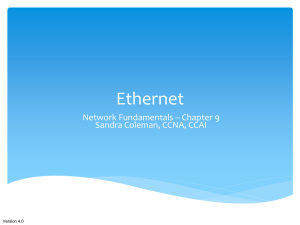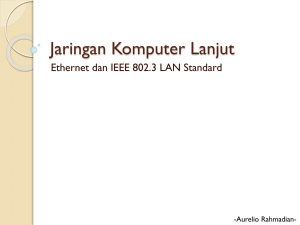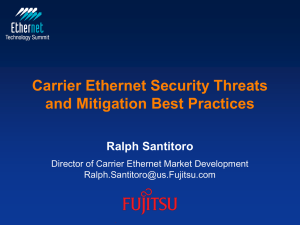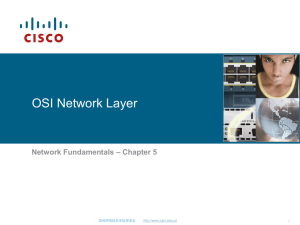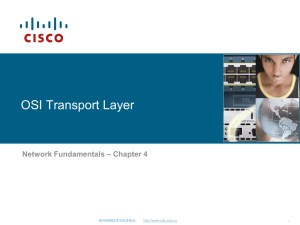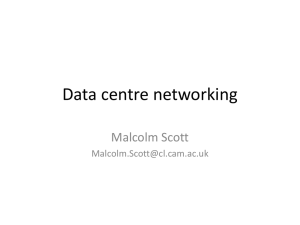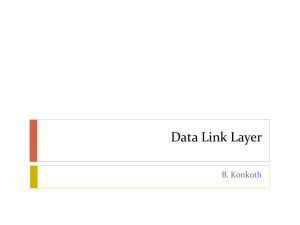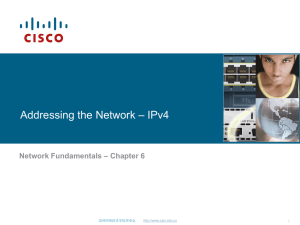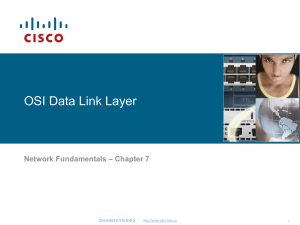9.4.2 CSMA/CD – The Process
advertisement
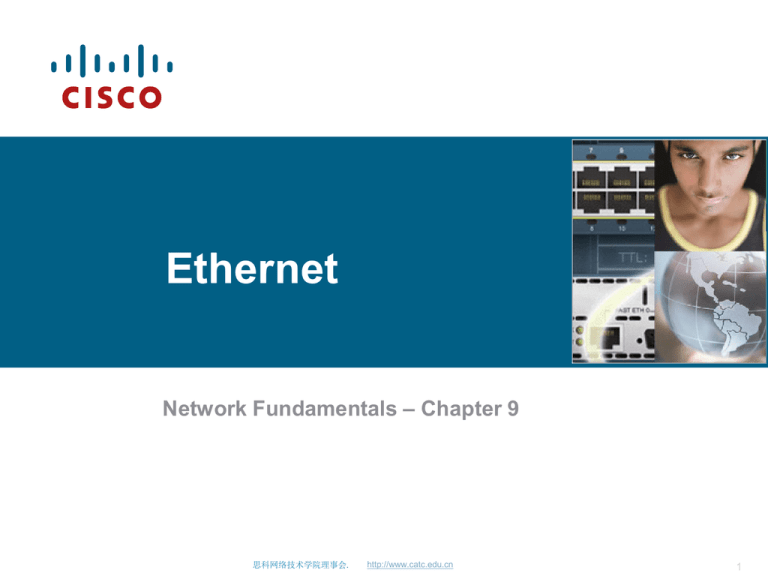
Ethernet Network Fundamentals – Chapter 9 思科网络技术学院理事会. http://www.catc.edu.cn 1 Objectives Identify the basic characteristics of network media used in Ethernet. Describe the physical and data link features of Ethernet. Describe the function and characteristics of the media access control method used by Ethernet protocol. Explain the importance of Layer 2 addressing used for data transmission and determine how the different types of addressing impacts network operation and performance. Compare and contrast the application and benefits of using Ethernet switches in a LAN as apposed to using hubs. Explain the ARP process. 思科网络技术学院理事会. http://www.catc.edu.cn 2 Context Index 9.1 Overview of Ethernet 9.2 Ethernet-Communication through the LAN 9.3 The Ethernet Frame 9.4 Ethernet Media Access Control 9.5 Ethernet Physical Layer 9.6 Hubs and Switches 9.7 Address Resolution Protocol (ARP) 9.8 Chapter Labs 9.9 Chapter Summary 思科网络技术学院理事会. http://www.catc.edu.cn 3 9.1 Overview of Ethernet 思科网络技术学院理事会. http://www.catc.edu.cn 4 9.1.1 Ethernet - Standerds and Implementation The first Ethernet standard was published in 1980 by a consortium of Digital Equipment Corporation, Intel, and Xerox (DIX). In 1985, the Institute of Electrical and Electronics Engineers (IEEE) standards committee for Local and Metropolitan Networks published standards for LANs. The standard for Ethernet is 802.3. Ethernet operates in the lower two layers of the OSI model: the of the Data Link layer and the Physical layer. 思科网络技术学院理事会. http://www.catc.edu.cn 5 9.1.2 Ethernet - Layer 1 and Layer 2 Ethernet at Layer 1 involves signals, bit streams that travel on the media, physical components that put signals on media, and various topologies. The Data Link sublayers contribute significantly to technological compatibility and computer communications. the Media Access Control (MAC) sublayer The Logical Link Control (LLC) sublayer 思科网络技术学院理事会. http://www.catc.edu.cn 6 9.1.3 Logical Link Control-Connecting to the Upper Layers For Ethernet, the IEEE 802.2 standard describes the LLC sublayer functions, and the 802.3 standard describes the MAC sublayer and the Physical layer functions. The LLC sublayer takes the network protocol data, which is typically an IPv4 packet, and adds control information to help deliver the packet to the destination node. Layer 2 communicates with the upper layers through LLC. 思科网络技术学院理事会. http://www.catc.edu.cn 7 9.1.4 MAC – Getting Data to the Media Media Access Control (MAC) is the lower Ethernet sublayer of the Data Link layer. Media Access Control is implemented by hardware, typically in the computer Network Interface Card (NIC). The Ethernet MAC sublayer has two primary responsibilities: Data Encapsulation Media Access Control 思科网络技术学院理事会. http://www.catc.edu.cn 8 9.1.5 Physical Implementations of Ethernet The success of Ethernet is due to the following factors: –Simplicity and ease of maintenance –Ability to incorporate new technologies –Reliability –Low cost of installation and upgrade In today's networks, Ethernet uses UTP copper cables and optical fiber to interconnect network devices via intermediary devices such as hubs and switches. 思科网络技术学院理事会. http://www.catc.edu.cn 9 9.2 Ethernet-Communication through the LAN 思科网络技术学院理事会. http://www.catc.edu.cn 10 9.2.1 Historic Ethernet The foundation for Ethernet technology was first established in 1970 with a program called Alohanet. The first version of Ethernet incorporated a media access method known as Carrier Sense Multiple Access with Collision Detection (CSMA/CD). CSMA/CD managed the problems that result when multiple devices attempt to communicate over a shared physical medium. 思科网络技术学院理事会. http://www.catc.edu.cn 11 9.2.1 Historic Ethernet The first versions of Ethernet used coaxial cable to connect computers in a bus topology. Thicknet, (10BASE5) Thinnet (10BASE2) The physical topology was also changed to a star topology using hubs. The original media were replaced by early categories of UTP cables. 思科网络技术学院理事会. http://www.catc.edu.cn 12 9.2.2 Ethernet Collision Management Current Ethernet----full-duplex Legacy Ethernet---half-duplex Because the media is shared, only one station could successfully transmit at a time. As more devices were added to an Ethernet network, the amount of frame collisions increased significantly. 思科网络技术学院理事会. Switches can control the flow of data by isolating each port and sending a frame only to its proper destination (if the destination is known), rather than send every frame to every device. http://www.catc.edu.cn 13 9.2.3 Moving to 1Gbps and Beyond Some of the equipment and cabling in modern, well-designed and installed networks may be capable of working at the higher speeds with only minimal upgrading. 思科网络技术学院理事会. http://www.catc.edu.cn 14 9.2.3 Moving to 1Gbps and Beyond The increased cabling distances enabled by the use of fiber-optic cable in Ethernetbased networks has resulted in a blurring of the distinction between LANs and WANs. It can now be applied across a city in what is known as a Metropolitan Area Network (MAN). 思科网络技术学院理事会. http://www.catc.edu.cn 15 9.3 The Ethernet Frame 思科网络技术学院理事会. http://www.catc.edu.cn 16 9.3.1 The Frame – Encapsulating the Packet The Ethernet frame structure adds headers and trailers around the Layer 3 PDU to encapsulate the message being sent. There are two styles of Ethernet framing: IEEE 802.3 (original) and the revised IEEE 802.3 (Ethernet). 思科网络技术学院理事会. http://www.catc.edu.cn 17 9.3.1 The Frame – Encapsulating the Packet The Preamble (7 bytes) and Start Frame Delimiter (SFD) (1 byte) fields are used for synchronization between the sending and receiving devices. The Destination MAC Address field (6 bytes) is the identifier for the intended recipient. The Source MAC Address field (6 bytes) identifies the frame's originating NIC or interface. The Length/Type field (2 bytes) defines the exact length of the frame's data field. The Data and Pad fields (46 - 1500 bytes) contains the encapsulated data from a higher layer, which is a generic Layer 3 PDU, or more commonly, an IPv4 packet. The Frame Check Sequence (FCS) field (4 bytes) is used to detect errors in a frame. It uses a cyclic redundancy check (CRC). 思科网络技术学院理事会. http://www.catc.edu.cn 18 9.3.2 The Ethernet MAC Address A unique identifier called a Media Access Control (MAC) address was created to assist in determining the source and destination address within an Ethernet network. MAC addressing is added as part of a Layer 2 PDU. An Ethernet MAC address is a 48-bit binary value expressed as 12 hexadecimal digits. 思科网络技术学院理事会. http://www.catc.edu.cn 19 9.3.2 The Ethernet MAC Address IEEE requires a vendor to follow two simple rules: –All MAC addresses assigned to a NIC or other Ethernet device must use that vendor's assigned OUI as the first 3 bytes. –All MAC addresses with the same OUI must be assigned a unique value (vendor code or serial number) in the last 3 bytes. The address is encoded into the ROM chip permanently - it cannot be changed by software. 思科网络技术学院理事会. http://www.catc.edu.cn 20 9.3.3 Hexadecimal Numbering and Addressing Hexadecimal ("Hex") is a base sixteen numbering system uses the numbers 0 to 9 and the letters A to F. Hexadecimal is usually represented in text by the value preceded by 0x (for example 0x73) or a subscript 16. 思科网络技术学院理事会. http://www.catc.edu.cn 21 9.3.3 Hexadecimal Numbering and Addressing Hexadecimal is used to represent Ethernet MAC addresses and IP Version 6 addresses. You have seen hexadecimal used in the Packets Byte pane of Wireshark where it is used to represent the binary values within frames and packets. 思科网络技术学院理事会. http://www.catc.edu.cn 22 9.3.4 Another Layer of Addressing OSI Data Link layer (Layer 2) physical addressing, implemented as an Ethernet MAC address, is used to transport the frame across the local media. Network layer (Layer 3) addresses, such as IPv4 addresses, provide the ubiquitous, logical addressing that is understood at both source and destination. 思科网络技术学院理事会. http://www.catc.edu.cn 23 9.3.5 Ethernet Unicast, Multicast & Broadcast In Ethernet, different MAC addresses are used for Layer 2 unicast, multicast, and broadcast communications. A unicast MAC address is the unique address used when a frame is sent from a single transmitting device to single destination device. 思科网络技术学院理事会. http://www.catc.edu.cn 24 9.3.5 Ethernet Unicast, Multicast & Broadcast With a broadcast, the packet contains a destination IP address that has all ones (1s) in the host portion. This numbering in the address means that all hosts on that local network (broadcast domain) will receive and process the packet. Many network protocols, such as Dynamic Host Configuration Protocol (DHCP) and Address Resolution Protocol (ARP), use broadcasts. 思科网络技术学院理事会. http://www.catc.edu.cn 25 9.3.5 Ethernet Unicast, Multicast & Broadcast Recall that multicast addresses allow a source device to send a packet to a group of devices. Devices that belong to a multicast group are assigned a multicast group IP address. The range of multicast addresses is from 224.0.0.0 to 239.255.255.255. 思科网络技术学院理事会. http://www.catc.edu.cn 26 9.4 Ethernet Media Access Control 思科网络技术学院理事会. http://www.catc.edu.cn 27 9.4.1 Media Access Control in Ethernet Ethernet uses Carrier Sense Multiple Access with Collision Detection (CSMA/CD) to detect and handle collisions and manage the resumption of communications. A device can then determine when it can transmit. When a device detects that no other computer is sending a frame, or carrier signal, the device will transmit, if it has something to send. 思科网络技术学院理事会. http://www.catc.edu.cn 28 9.4.2 CSMA/CD – The Process Carrier Sense----In the CSMA/CD access method, all network devices that have messages to send must listen before transmitting. Multi-access---The media now has two devices transmitting their signals at the same time. Collision Detection----When a device is in listening mode, it can detect when a collision occurs on the shared media. Jam Signal and Random Backoff ---Once the collision is detected by the transmitting devices, they send out a jamming signal. This jamming signal is used to notify the other devices of a collision, so that they will invoke a backoff algorithm. This backoff algorithm causes all devices to stop transmitting for a random amount of time, which allows the collision signals to subside. 思科网络技术学院理事会. http://www.catc.edu.cn 29 9.4.2 CSMA/CD – The Process Carrier Sense Multiple Access with Collision Detection(CSMA/CD) 1 2 思科网络技术学院理事会. http://www.catc.edu.cn 30 9.4.2 CSMA/CD – The Process Carrier Sense Multiple Access with Collision Detection(CSMA/CD) 3 4 思科网络技术学院理事会. http://www.catc.edu.cn 31 9.4.2 CSMA/CD – The Process Carrier Sense Multiple Access with Collision Detection(CSMA/CD) 5 6 思科网络技术学院理事会. http://www.catc.edu.cn 32 9.4.2 CSMA/CD – The Process Carrier Sense Multiple Access with Collision Detection(CSMA/CD) 7 8 思科网络技术学院理事会. http://www.catc.edu.cn 33 9.4.2 CSMA/CD – The Process Carrier Sense Multiple Access with Collision Detection(CSMA/CD) 9 10 思科网络技术学院理事会. http://www.catc.edu.cn 34 9.4.2 CSMA/CD – The Process Given that collisions will occur occasionally in any shared media topology even when employing CSMA/CD. The connected devices that access a common media via a hub or series of directly connected hubs make up what is known as a collision domain. A collision domain is also referred to as a network segment. Hubs and repeaters therefore have the effect of increasing the size of the collision domain. 思科网络技术学院理事会. http://www.catc.edu.cn 35 9.4.2 CSMA/CD – The Process In this Packet Tracer Activity, you will build large collision domains to view the effects of collisions on data transmission and network operation. 思科网络技术学院理事会. http://www.catc.edu.cn 36 9.4.3 Ethernet Timing The electrical signal that is transmitted takes a certain amount of time (latency) to propagate (travel) down the cable. Each hub or repeater in the signal's path adds latency as it forwards the bits from one port to the next. This accumulated delay increases the likelihood that collisions will occur because a listening node may transition into transmitting while the hub or repeater is processing the message. 思科网络技术学院理事会. http://www.catc.edu.cn 37 9.4.3 Ethernet Timing Ethernet with throughput speeds of 10 Mbps and slower are asynchronous. An asynchronous communication in this context means that each receiving device will use the 8 bytes of timing information to synchronize the receive circuit to the incoming data and then discard the 8 bytes. Ethernet implementations with throughput of 100 Mbps and higher are synchronous. Synchronous communication in this context means that the timing information is not required. 思科网络技术学院理事会. http://www.catc.edu.cn 38 9.4.3 Ethernet Timing For each different media speed, a period of time is required for a bit to be placed and sensed on the media. This period of time is referred to as the bit time. Slot time is the time it takes for an electronic pulse to travel the length of the maximum theoretical distance between two nodes.It is also the time that a transmitting station waits before attempting to retransmit following a collision. 思科网络技术学院理事会. http://www.catc.edu.cn 39 9.4.4 Interframe Spacing and Backoff The Ethernet standards require a minimum spacing between two noncolliding frames. This gives the media time to stabilize after the transmission of the previous frame and time for the devices to process the frame. Referred to as the interframe spacing, this time is measured from the last bit of the FCS field of one frame to the first bit of the Preamble of the next frame. 思科网络技术学院理事会. http://www.catc.edu.cn 40 9.4.4 Interframe Spacing and Backoff As soon as a collision is detected, the sending devices transmit a 32-bit "jam" signal that will enforce the collision. This ensures all devices in the LAN to detect the collision. 思科网络技术学院理事会. http://www.catc.edu.cn 41 9.4.4 Interframe Spacing and Backoff Backoff Timing----After a collision occurs and all devices allow the cable to become idle (each waits the full interframe spacing), the devices whose transmissions collided must wait an additional - and potentially progressively longer period of time before attempting to retransmit the collided frame. 思科网络技术学院理事会. http://www.catc.edu.cn 42 9.5 Ethernet Physical Layer 思科网络技术学院理事会. http://www.catc.edu.cn 43 9.5.1 Overview of Ethernet Physical Layer Ethernet is covered by the IEEE 802.3 standards. Four data rates are currently defined for operation over optical fiber and twisted-pair cables: 10 Mbps - 10Base-T Ethernet 100 Mbps - Fast Ethernet 1000 Mbps - Gigabit Ethernet 10 Gbps - 10 Gigabit Ethernet 思科网络技术学院理事会. http://www.catc.edu.cn 44 9.5.2 10 and 100 Mbps Ethernet The principal 10 Mbps implementations of Ethernet include: 10BASE5 using Thicknet coaxial cable 10BASE2 using Thinnet coaxial cable 10BASE-T using Cat3/Cat5 unshielded twisted-pair cable 思科网络技术学院理事会. http://www.catc.edu.cn 45 9.5.2 10 and 100 Mbps Ethernet 100 Mbps Ethernet, also known as Fast Ethernet, can be implemented using twisted-pair copper wire or fiber media. The most popular implementations of 100 Mbps Ethernet are: 100BASE-TX using Cat5 or later UTP 100BASE-FX using fiber-optic cable 思科网络技术学院理事会. http://www.catc.edu.cn 46 9.5.3 1000 Mbps Ethernet The development of Gigabit Ethernet standards resulted in specifications for UTP copper, single-mode fiber, and multimode fiber. 1000BASE-T Ethernet provides full-duplex transmission using all four pairs in Category 5 or later UTP cable. 思科网络技术学院理事会. http://www.catc.edu.cn 47 9.5.3 1000 Mbps Ethernet The fiber versions of Gigabit Ethernet - 1000BASE-SX and 1000BASE-LX - offer the following advantages over UTP: noise immunity, small physical size, and increased unrepeated distances and bandwidth. 思科网络技术学院理事会. http://www.catc.edu.cn 48 9.5.4 Ethernet – Future Options The IEEE 802.3ae standard was adapted to include 10 Gbps, full-duplex transmission over fiber-optic cable. 10-Gigabit Ethernet (10GbE) is evolving for use not only in LANs, but also for use in WANs and MANs. Although 1-Gigabit Ethernet is now widely available and 10-Gigabit products are becoming more available, the IEEE and the 10-Gigabit Ethernet Alliance are working on 40-, 100-, or even 160-Gbps standards. 思科网络技术学院理事会. http://www.catc.edu.cn 49 9.6 Hubs and Switches 思科网络技术学院理事会. http://www.catc.edu.cn 50 9.6.1 Legacy Ethernet – Using Hubs Classic Ethernet uses hubs to interconnect nodes on the LAN segment. Hubs do not perform any type of traffic filtering. 思科网络技术学院理事会. http://www.catc.edu.cn 51 9.6.2 Ethernet – Using Switches Switches allow the segmentation of the LAN into separate collision domains. 思科网络技术学院理事会. http://www.catc.edu.cn 52 9.6.2 Ethernet – Using Switches In a LAN where all nodes are connected directly to the switch, the throughput of the network increases dramatically. The three primary reasons for this increase are: Dedicated bandwidth to each port Collision-free environment Full-duplex operation 思科网络技术学院理事会. http://www.catc.edu.cn 53 9.6.2 Ethernet – Using Switches In this activity, we provide a model for comparing the collisions found in hub-based networks with the collision-free behavior of switches. 思科网络技术学院理事会. http://www.catc.edu.cn 54 9.6.3 Switches – Selective Forwording Ethernet switches selectively forward individual frames from a receiving port to the port where the destination node is connected. The switch maintains a table, called a MAC table. that matches a destination MAC address with the port used to connect to a node. 思科网络技术学院理事会. http://www.catc.edu.cn 55 9.6.3 Switches – Selective Forwording To accomplish their purpose, Ethernet LAN switches use five basic operations: Learning Aging Flooding Selective Forwarding Filtering 1 思科网络技术学院理事会. http://www.catc.edu.cn 56 9.6.3 Switches – Selective Forwording 2 3 思科网络技术学院理事会. http://www.catc.edu.cn 57 9.6.3 Switches – Selective Forwording 4 5 思科网络技术学院理事会. http://www.catc.edu.cn 58 9.6.3 Switches – Selective Forwording 6 7 思科网络技术学院理事会. http://www.catc.edu.cn 59 9.6.4 Ethernet – Comparing Hubs and Switches Answer the questions below using the information 1. Where will the switch forword the frame? 思科网络技术学院理事会. http://www.catc.edu.cn 60 9.6.4 Ethernet – Comparing Hubs and Switches 2. When the switch forwards the frame, which statement(s) are true ? Switch adds the source MAC address to the MAC table. Frame is a broadcast frame and will be forwarded to all ports. Frame is a unicast frame and will be sent to specific port only. Frame is a unicast frame and will be flooded to all ports. Frame is a unicast frame but it will be fropped at the switch. 思科网络技术学院理事会. http://www.catc.edu.cn 61 9.6.4 Ethernet – Comparing Hubs and Switches In this activity, you will have the opportunity to visualize and experiment with the behavior of switches in a network. 思科网络技术学院理事会. http://www.catc.edu.cn 62 9.7 Address Resolution Protocol(ARP) 思科网络技术学院理事会. http://www.catc.edu.cn 63 9.7.1 The ARP Process – Mapping IP to MAC Addresses The ARP protocol provides two basic functions: Resolving IPv4 addresses to MAC addresses Maintaining a cache of mappings 1 思科网络技术学院理事会. http://www.catc.edu.cn 64 9.7.1 The ARP Process – Mapping IP to MAC Addresses 2 思科网络技术学院理事会. http://www.catc.edu.cn 65 9.7.1 The ARP Process – Mapping IP to MAC Addresses 3 思科网络技术学院理事会. http://www.catc.edu.cn 66 9.7.1 The ARP Process – Mapping IP to MAC Addresses 4 思科网络技术学院理事会. http://www.catc.edu.cn 67 9.7.1 The ARP Process – Mapping IP to MAC Addresses 5 思科网络技术学院理事会. http://www.catc.edu.cn 68 9.7.1 The ARP Process – Mapping IP to MAC Addresses 6 思科网络技术学院理事会. http://www.catc.edu.cn 69 9.7.2 The ARP Process – Destinations outside the Local Network If the destination IPv4 host is not on the local network, the source node needs to deliver the frame to the router interface that is the gateway or next hop used to reach that destination. The source node will use the MAC address of the gateway as the destination address for frames containing an IPv4 packet addressed to hosts on other networks. 1 思科网络技术学院理事会. http://www.catc.edu.cn 70 9.7.2 The ARP Process – Destinations outside the Local Network 2 思科网络技术学院理事会. http://www.catc.edu.cn 71 9.7.2 The ARP Process – Destinations outside the Local Network 3 思科网络技术学院理事会. http://www.catc.edu.cn 72 9.7.2 The ARP Process – Destinations outside the Local Network 4 思科网络技术学院理事会. http://www.catc.edu.cn 73 9.7.2 The ARP Process – Destinations outside the Local Network 5 思科网络技术学院理事会. http://www.catc.edu.cn 74 9.7.2 The ARP Process – Destinations outside the Local Network 6 思科网络技术学院理事会. http://www.catc.edu.cn 75 9.7.2 The ARP Process – Destinations outside the Local Network Using proxy ARP, a router interface acts as if it is the host with the IPv4 address requested by the ARP request. Another case where a proxy ARP is used is when a host believes that it is directly connected to the same logical network as the destination host. This generally occurs when a host is configured with an improper mask. Another use for a proxy ARP is when a host is not configured with a default gateway. 思科网络技术学院理事会. http://www.catc.edu.cn 76 9.7.3 The ARP Process – Removing Address Mappings For each device, an ARP cache timer removes ARP entries that have not been used for a specified period of time. The times differ depending on the device and its operating system. 思科网络技术学院理事会. http://www.catc.edu.cn 77 9.7.4 ARP Broadcasts - Issues Overhead on the Media Security--ARP spoofing/ARP poisoning 思科网络技术学院理事会. http://www.catc.edu.cn 78 9.8 Chapter Labs 思科网络技术学院理事会. http://www.catc.edu.cn 79 9.8.1 Lab-Address Resolution Protocol(ARP) This lab introduces the Windows arp utility command to examine and change ARP cache entries on a host computer. Then Wireshark is used to capture and analyze ARP exchanges between network devices. In this activity, you will use Packet Tracer to examine and change ARP cache entries on a host computer. 思科网络技术学院理事会. http://www.catc.edu.cn 80 9.8.2 Lab-Cisco Switch MAC Table Examination In this lab, you will connect to a switch via a Telnet session, log in, and use the required operating system commands to examine the stored MAC addresses and their association to switch ports. In this activity, you will use Packet tracer to examine the stored MAC addresses and their association to switch ports. 思科网络技术学院理事会. http://www.catc.edu.cn 81 9.8.3 Lab-Intermediary Device as an End Device This lab uses Wireshark to capture and analyze frames to determine which network nodes originated the frames. A Telnet session between a host computer and switch is then captured and analyzed for frame content. In this activity, you will use Packet Tracer to analyze frames originating from a switch. 思科网络技术学院理事会. http://www.catc.edu.cn 82 9.9 Chapter Summary 思科网络技术学院理事会. http://www.catc.edu.cn 83 Summary Identify the basic characteristics of network media used in Ethernet. Describe the Physical and Data Link layer features of Ethernet. Describe the function and characteristics of the media access control method used by Ethernet protocol. Explain the importance of Layer 2 addressing used for data transmission and determine how the different types of addressing impacts network operation and performance. Compare and contrast the application and benefits of using Ethernet switches in a LAN as opposed to using hubs. Explain the ARP process. 思科网络技术学院理事会. http://www.catc.edu.cn 84 思科网络技术学院理事会. http://www.catc.edu.cn 85

